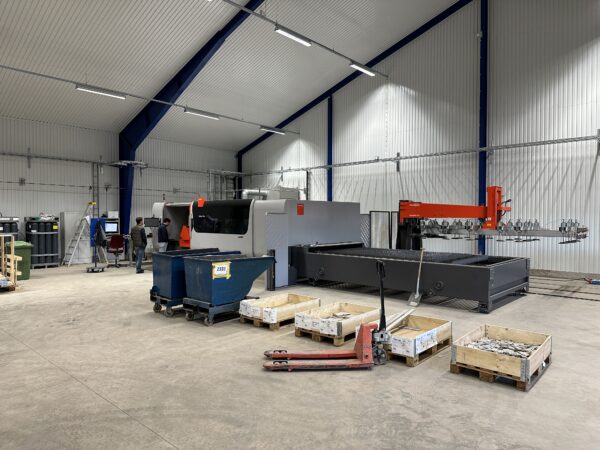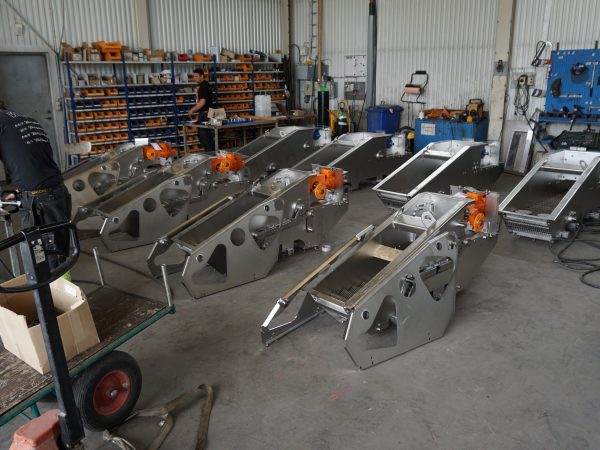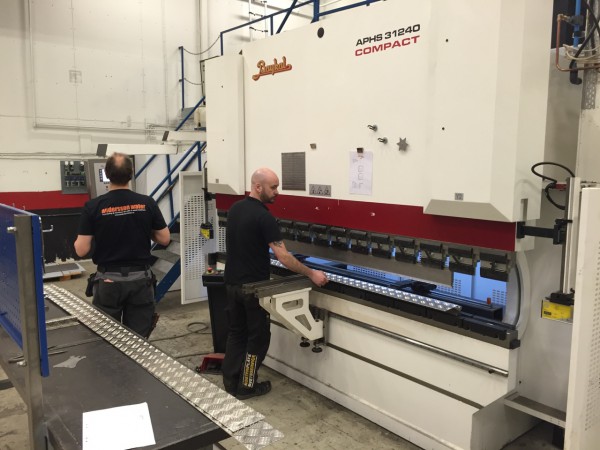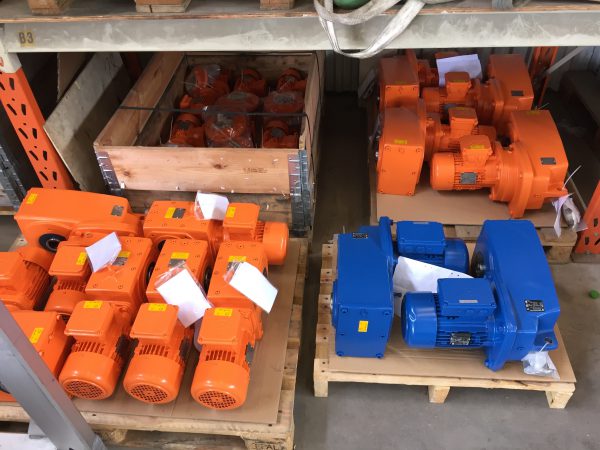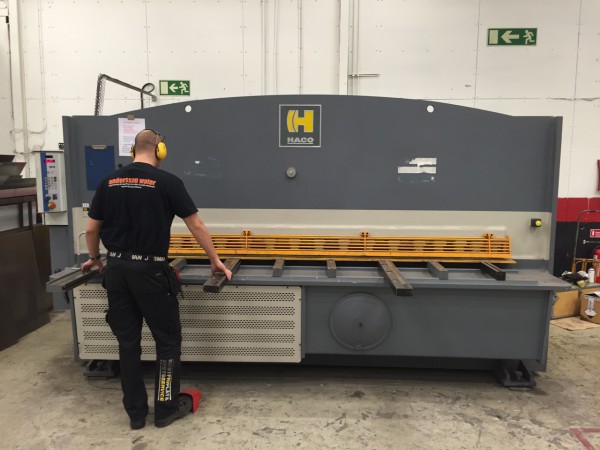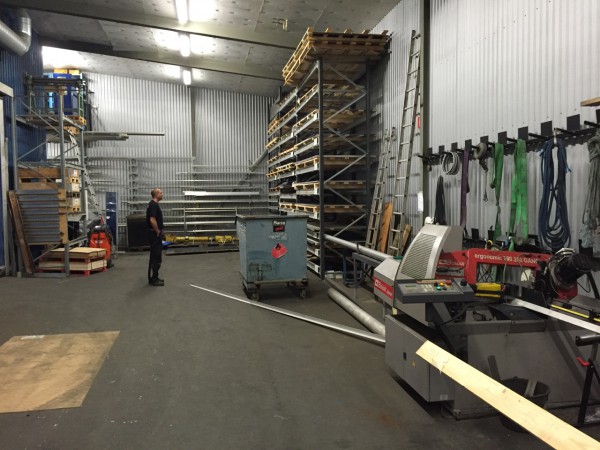Andersson Water products are made in Sweden.
Our ambition is to provide the strongest machines on the market.
The equipment is produced according to ISO and CE norms.
Our design and project team and our service and production team has worked with thousands of screen projects for over 30 years around the world.
Empresa
We have been dedicated to screens for over 30 years actively working all around the world. Our speciality is step type fine screens for waste water plant headworks and greasy water & waste applications. We are currently the only company that have worked with all step screen makers with original experience. Within screens & screenings handling Andersson Water has unique capabilities on design & application knowledge and extensive international marketing & support. We aim to provide the highest level of service & strongest quality machinery.
Andersson Water products was developed year 2000-2001 and have references and distributors all around the world. The Stair Screen is the worlds strongest step screen.
The step screen story
Inventor Carl-Otto Wallander had since the 70s been in the water treatment business running company Hydropress with hydraulic coarse waste ram presses and coarse screens as main products.
In the beginning of the 80s a new fine screen concept was invented by Carl-Otto. The Step Screen was born. A revolution in mechanical water screening. For the first time in water treatment history it was possible to replace coarse 10-30mm screens with 1-6mm screens in existing concrete channels while keeping the same hydraulic profile. (Low head 200-300mm, high velocity 0.5-1m/s). And ontop of that the screen was totally selfcleaning by its own movement. It could handle fat, grease, oil, and concentrated waste water with ease. In fact it liked grease! And furthermore its ingenious step by step operation by level control creates a precoat mat of screenings on its surface. Which further enhances separation to better than the bar spacing. Andersson worked with Wallander on step screen designs and build and installation of the first “chain free” step screen with submersible linkage transmission system which has been developed in many versions. Andersson Stair Screen has the strongest drive ever made on a step screen.
What is a step screen?
A step type screen is a mechanical ”moving” bar slot screen. Where the step shape of the bars performs the ”raking/conveying” by the bars own movement. This is very different to most traditional screen technologies on the market that are commonly either mechanically raked ”fixed” bar slot screens or perforated screens with baskets, drums, panel bands or belts. Fixed bar screens and perforated screens had been around long before the arrival of step screens. But them having so many natural limitations. Limitations which those screens still have today. The step screen overcomes those limitations and is still today the most usable and versatile waste water fine screening method.
How does a step screen work?
The step screen construction consists of 2 constantly interleaved and permanently aligned self supporting sets of step shaped bars. The constantly interleaved stepped bars has a high cross section depth approx 100mm and they strongly support eachother while interleaved. This allows usage of relatively thin bars (3mm). The motion between the bars makes it totally selfcleaning by its own movement. The optimum step screen bar thickness is 3mm. This allows for 1-6mm bar spacing. Which gives 25-67% effective wet area. Ontop of that its 45-60 degree bar inclination increases the wet area by another approx 20-40% compared to steep or vertical screens.
Most ”fixed” bar screens have a steep bar inclination of 75-90 degrees. Fixed bar rake screens requires much thicker bars than step screens (typically 6-12mm) to maintain the individual bar strength. Such a bar thickness highly limits the wet area which in combination with steep inclination and critical need for rake alignment makes fixed bar screens limited when it comes to finer screening than 6-10mm. This is where step screens excel by easily going down to 2-3mm in the same hydraulic situations as 6-10mm fixed bar screens. Rake screens are great for >10-20mm coarse screening to protect pumps and in situations where theres no need to take out more than <5-10% of the screenings which is all that can be expected from a >10-20mm fixed bar rake screen. Coarse rake screens are not needed to protect strong step screens. Andersson Water have rake screens and perforated screens as well as step screens. Our CRS rake screens are mainly used as >20mm coarse screens in deep pumping stations. Thats were rake screens fit best. Andersson Water have perforated screens as well as rake screens but we are careful using them on greasy clogging wearing applications such as sewage waste water where big objects may come which could cause damage to perforated panels requiring a coarse pre screen stage. Again step screen has none of these issues and a single 2-3mm fine screen stage can be used without concern.
Step screens are level controlled intermittent step by step and works with an active precoat layer of screenings “screenings mat”. During step by step screenings mat level control the flow is evenly and calmly distributed through the mat over the entire screen surface. The precoat mat control gives a 3mm step screen 80% capture which is comparable with 6mm perforated screens. A traditional fixed bar rake screen cannot maintain a screenings precoat mat and the rake causes a strong rush of water through the screen with every raking. This gives lower screenings capture on fixed bar rake screens. Replacing a 6mm rake screen with a 6mm step screen gives huge savings in maintenance in the following process due the the higher separation provided by the precoat screenings mat on Stair Screens. The mat is possible by the higher wet area and step by step level control.
Independent tests has been performed on 3mm step screens with right control and screenings pre coat mat to verify their capture rate of 80% acc to international screen evaluation methods. Its important that step screens are operated with step by step level control and precoat mat. Running them on timer or crude level control will cause poor results. Unfortunately this faulty control has caused poor results in some SCR tests and is unfortunately the way many step screens around the world are operated. Step by step level precoat mat control is essential.
A fixed bar screen as well as a moving bar step screen without right screenings mat level control will have much less capture rate. Maybe only 40%. It is the step screen mat and the slower through velocity which makes the difference giving huge operation savings in the following wwtp process from using a 6mm step screen compared to a 6mm fixed bar rake screen. And since a <2-3mm step screen easily can be used instead of a 6mm rake screen, the savings are even greater!
Since the moving bar step screen concept makes it totally selfcleaning by its own movement (no brushes, no flushing) its full wet area can by effectively used with low permanent clogging margins taken into respect. And because of the constantly interleaved step screen bar sets that never leave eachother completely there are no rake alignment issues. This enables down to 1mm moving bar step screens. Again fixed bar rake screens are difficult to make below 6mm bar spacing. Not only because of limited wet area but also because of rake alignment issues. Perforated screens are also difficult to make much finer than 6mm on wwtp´s because of limited wet area and high clog rate. Perforated screening media (perforated plate) is thin <2-3mm which further weakens fine perforated screens which are already thin and can wear from both sand and even wear from its own mechanical brushing tearing up the holes from round to long oval. The gathered strength and wear surface on the step screens bars is huge compared to perforated screens!
The moving step shaped bars on a step screen ”rakes the screen” and at the same time conveys the separated screenings solids up step by step under level control. Towards the discharge point where it automatically drops off without need for brushing, spraying, or any discharge scraper mechanism. Its silent and all covers can be opened without risk of getting sprayed with unhealthy aerosols from spraying which is needed on all perforated screens.
Step screens are simple but difficult…
Step screens look simple but theyre very demanding to design.. Its ingenious self cleaning action can create huge friction forces from sand. The mechanical stresses from that is unpredictable. It takes decades of experience to get it right. Every year on international trade fairs there are new step screen copies. And the next year most of them are gone… Unfortunatly all of these copies has given the step screen concept a bad name on many markets. This is due to the copiers incompetence and has little to do with the concept itself. As of today our opinion is that there are only 3 step screen makes in the world with designs based on original experience.
Step screens vs Perforated screens?
Yes, a 6mm hole is more effective than a 6mm slot. But all perforated screens are quite limited in capacity and are unpredictable in clogging & head requirement. This makes perforated screens hard to use in existing hydraulics/channels. And they all require brushes and/or flushing to keep from clogging by greasy waste water. Its not uncommon that a perforated band screen requires 50-100m3/day of spray water. Thats up to 50-200 euro per day in water cost alone! A huge waste of resources! A 3mm strong step screen will give comparable separation to a 6mm perforated screen but with much higher capacity and much less maintenance. Perforated screens are excellent for low clogging, low flow, stable flow, simple applications like water intakes. But as headworks inlet screens and other greasy concentrated applications they come short of strong step screens. Perforated screens are unpredictable on greasy applications like wwtp´s. Their head requirement, flow capacity, need of brushing and spray water (even hot water sometimes) is highly unpredictable. There are even perforated screen makers who claim that using thick plastic panels as screen media eliminates the need for mechanical brushing. This is a risky claim. The thicker the screen panels, the longer the hole passage which in turn increases the risk of permanent clogging from fibres and grease. Adding a brush on thick screen panels won’t help either much since brush bristles can’t pierce through long hole passages to clear them. Not even high pressure spraying will clear a fibre tangled perforation or mesh. Only mechanical shear/brushing can do that. Again step screens have none of these issues. Some plants who has decided for 3mm step screens after evaluation against 6mm perforated screens are Stockholm Henriksdal & Käppala who both replaced old 3mm step screens with new 3mm step screens. Also Gothenburg Rya wwtp and Malmö Sjölunda wwtp has chosen to install 2-3mm step screens after comparison with perforated screens. These plants are 400-800 000 pe with flows of 6-18 m3/s capacity each. These plants have peak loads of 4x the average flow and are heavily grit loaded from old combined sewers where road grit from streets are accumulating in the sewers during low flow. No coarse pre screening is needed before the 2-3mm step screens.
High pre screening separation at mebrane bio reactors (MBRs).
The capture of of a 2-3mm step screen is not enough for MBR pre screening. Something more is needed to separate short fine hair and that might clog the reactor material. Currently <1-2mm perforated round hole screen media is the preferred pre treatment to safeguard an MBR process. To give a 1-2mm perforated screen a chance of screening concentrated sewage something better is required upstreams than a >6mm fixed bar screen with <40% capture. A 6mm fixed bar screen leaves too much for the following 1-2mm perforated screens to handle. The best way to overcome this is to install a 2-3mm moving bar step screen pre screen stage with 80% capture in front of the 1-2mm perforated screen. This will properly offload the perforated screens providing conditions to for a 1-2mm perforated screen to function.
Is it strong enough?
There are some >20 000 step screen references around the world. Most of them being 3 or 6mm bar spacing. On a properly designed step screen there is no need for a protective coarse screening stage in front of the step screens. Big obstacles/debrie/stones >10mm will rarely damage a step screen. And the sand/grit that can cause blockage to a step screen will pass through a coarse pre screening stage of 10-30mm anyway. With step screens a whole screening stage can be saved! Although the step screen bars are “thin” 3mm their height/depth is approx 100mm compared to a bar height of 50mm on fixed bar screens. The bar height/depth is what carries the main forces. The side to side forces is handled by spacers closely spaced inbetween the step screen bars. Fixed bar screens has no spacers and cant have it since fixed bar screens are not self cleaning. Furthermore there are multiple bar carrying cross beams behind a step screen. Per about 2m bar length there are 6-8 cross beams whereas a fixed bar screen may have 1 cross beam per 2m bar length. This makes a step screen frame and bar structure stronger than fixed bar screens although thinner bars.
Can step screens handle grit?
The selfcleaning movement of a step screen can potentially cause great friction forces when the moving bar set moves through the fixed bar set. This friction force is transferred to the transmission and can lead to blockage/jamming. Weak screens cant handle this. Strong step screens can. These friction forces are unpredictable and impossible to theoretically engineer. This is where decades of experience makes the difference.
A properly constructed step screen is designed to handle grit loadings by absorbing the friction forces and distribute them evenly and safely before any damage occurs and give time for the overload sensor to eventually break the operation. All wwtps have grit loadings. Some more than others. Step screens are used at numerous heavily grit & screenings loaded big wwtps world wide. Without any pre screening! Strong step screens are designed to work under these conditions. Yes a step screen can be damaged by grit & sand sand in tons & meter depths. But no screen technology can handle that.
Step screens has no alignment issues and the gathered friction surface between all bars is huge. The huge friction surface makes the bars typically last >30 yrs which is the whole life span of a step screen. Perforated screens may not get blocked by sand but their thin perforated plate screen media is sensitive to wear from mechanical brushing and sand abrasion. Fixed bar rake screens may have thicker bars but a stone jammed deep inbetween the bars is stuck there since the rake teeth tines dont reach through the bar depth. Once stones start to accumulate between a fixed bar rake screen the bars are bent apart causing great forces on the rake teeth tines. When the rake teeth are thin which they need to be on <10mm bar spacing the teeth tines risks breaking off. The Stair Screen mat on the other hand will catch a lot of sand and the bars are designed to flex slightly to eventually work through grit or gravel in-between. This is part of the self cleaning step screen principle.
Should a step screen bar bend it can be easily replaced. Same goes for the bar spacers, should some break off they can easily be replaced. Step screens can handle higher open channel velocities than any other fine screen technology. This reduces the risk of grit settling in the channel which in turn further increases step screen operational performance and grit handling. Strong step screens can handle grit & sand better or just as good as any other fine screen. In fact the finer the bar spacing the stronger the self supporting bar action gets and the stronger the step screen surface gets.
Step screens are used all over
Over >20 000 1-6mm step screens are installed over the last 30 yrs at headworks world wide. This makes step screen one of the most common fine screen technologies used around the world. Its known for its low maintenance need and for its high flow/high separation capacity. Step screen is one of the great inventions in the water treatment business.
And remains the most versatile fine screening method.

